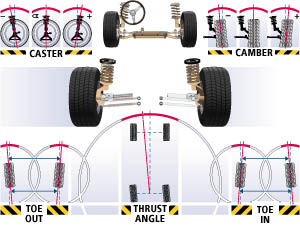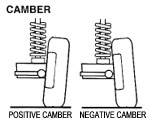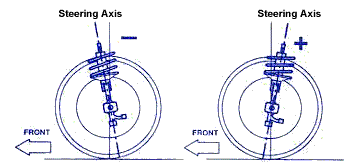What You Should Know About Wheel Alignments
Today, computerized alignment systems are used to align vehicles to the factory specifications. Today’s vehicles consist of non-adjustable and adjustable angles. If an angle is out of specification with no further adjustment possible, we must look for component damage.
This illustration shows the three major adjustments that are critical to a vehicles alignment: Toe, Caster, and Camber.

Toe – Refers to the in-ward or out-ward tilt of the tires in comparison to the other side. Toe-in refers to the tires being tilted toward one another. Toe-out refers to the tires being tilted outward of one another. Toe issues usually cause feathering of the tires.
Camber – Is the tilt of the wheel in and out on a vertical basis, viewed from the front. Negative (more) Camber is when the wheel is tilted in-ward, while Positive (less) Camber is tilted outward. Here are illustrations:
 |  |
Caster – Is the relationship between a vertical line from the bottom of the wheel to the top in relation to the ball-joints. Caster being out can give you bump steer – which is when you hit a bump your steering searches the road. See the illustration below:

Another angle that plays an effect in an alignment is the Thrust Angle. This is basically the relationship between all four wheels. See the picture at the top!
There are more angles that are in greater depth but this will give you a solid understanding of what alignment angles are and why they need to be adjusted.
Wheel Alignment Problems and Effects
Problem: Incorrect Camber Setting
Effect: Tire Wear Issues (usually inner or outer), Ball Joint/Wheel Bearing Wear
Problem: Too Much Positive Caster
Effect: Hard Steering, Excessive Road Shock, Wheel Shimmy
Problem: Too Much Negative Caster
Effect: Wander (i.e. bump steer), Weave, Instability at high speeds (death wobble)
Problem: Unequal Caster
Effect: Pull To Side Most negative/least positive caster
Problem: Incorrect Toe Setting
Effect: Tire Wear (feathering, inner and outer wear issues)
FiveStar ServiCenter uses computerized alignment equipment from the industry leader of such equipment.
